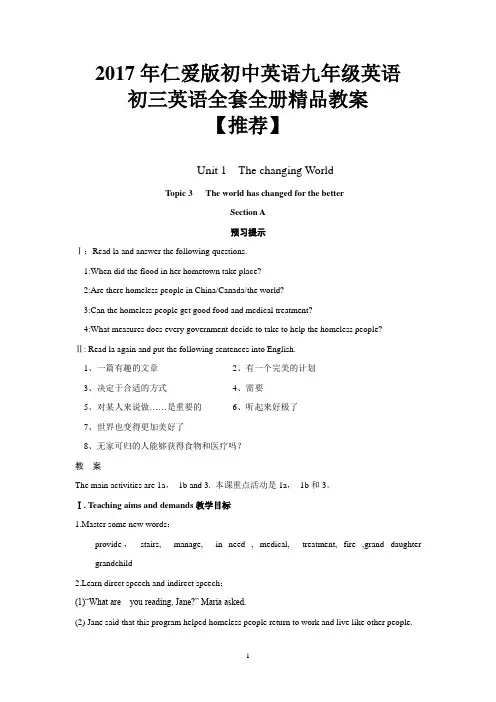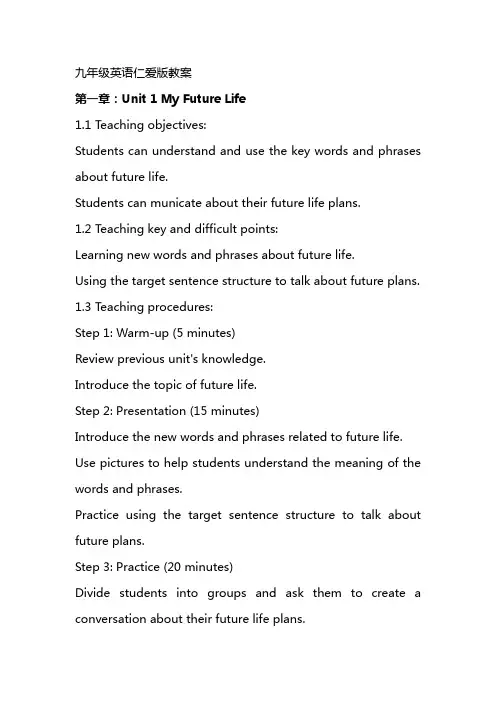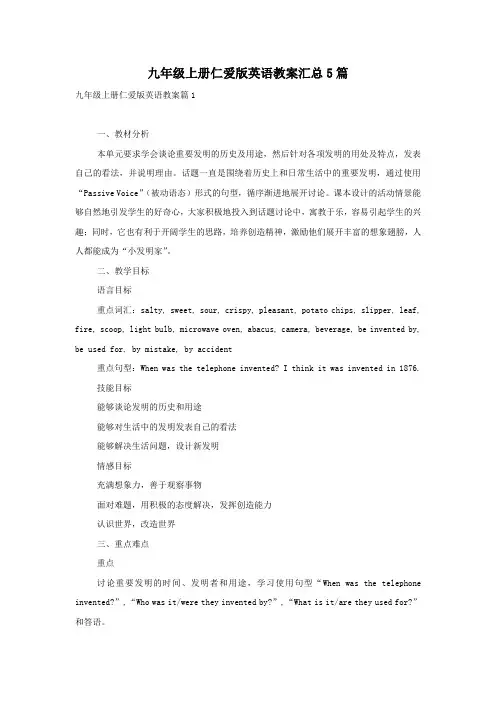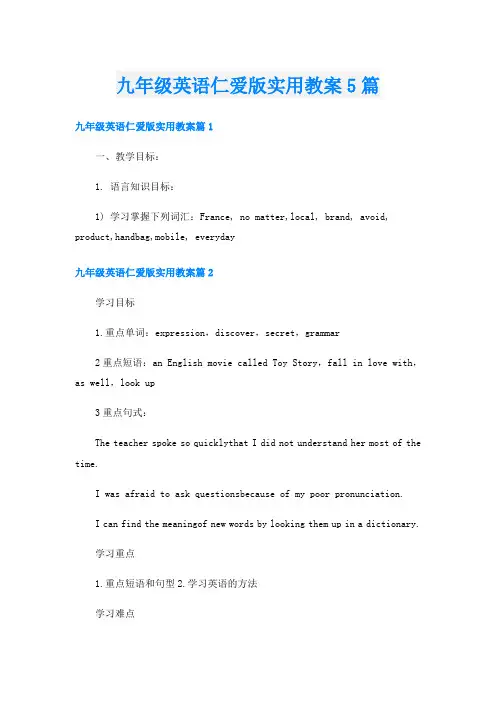最新2017版-仁爱版九年级英语上册全套教案
2017年仁爱版初中英语九年级英语初三英语全套全册精品教案【推荐】

2017年仁爱版初中英语九年级英语初三英语全套全册精品教案【推荐】Unit 1 The changing WorldTopic 3 The world has changed for the betterSection A预习提示Ⅰ:Read la and answer the following questions.1:When did the flood in her hometown take place?2:Are there homeless people in China/Canada/the world?3:Can the homeless people get good food and medical treatment?4:What measures does every government decide to take to help the homeless people?Ⅱ: Read la again and put the following sentences into English.1、一篇有趣的文章2、有一个完美的计划3、决定于合适的方式4、需要5、对某人来说做……是重要的6、听起来好极了7、世界也变得更加美好了8、无家可归的人能够获得食物和医疗吗?教案The main activities are 1a,1b and 3. 本课重点活动是1a,1b和3。
Ⅰ. Teaching aims and demands教学目标1.Master some new words:provide,stairs, manage, in need , medical, treatment, fire ,grand daughter grandchild2.Learn direct speech and indirect speech:(1)“What are you reading, Jane?” Maria asked.(2) Jane said that this program helped homeless people return to work and live like other people.3.Master word formation: Compounds4.Learn to help others in trouble.Ⅱ.Teaching aids教具多媒体/图片(流浪者/ 贫民窟/ 灾难)/小黑板或幻灯片Ⅲ.Five-step Teaching Plan五步教学方案Step 1 Review 第一步复习(时间:10分钟)(检查上节课作业,人口过密带来很多问题,引出本课话题。
九年级英语仁爱版教案

九年级英语仁爱版教案第一章:Unit 1 My Future Life1.1 Teaching objectives:Students can understand and use the key words and phrases about future life.Students can municate about their future life plans.1.2 Teaching key and difficult points:Learning new words and phrases about future life.Using the target sentence structure to talk about future plans.1.3 Teaching procedures:Step 1: Warm-up (5 minutes)Review previous unit's knowledge.Introduce the topic of future life.Step 2: Presentation (15 minutes)Introduce the new words and phrases related to future life. Use pictures to help students understand the meaning of the words and phrases.Practice using the target sentence structure to talk about future plans.Step 3: Practice (20 minutes)Divide students into groups and ask them to create a conversation about their future life plans.Encourage students to use the new words and phrases they have learned.Step 4: Consolidation (10 minutes)Ask students to write a short passage about their future life plans using the target sentence structure.Provide feedback and help students correct their mistakes.第二章:Unit 2 Our School2.1 Teaching objectives:Students can understand and use the key words and phrases about school.Students can describe their school and school life.2.2 Teaching key and difficult points:Learning new words and phrases about school.Using the target sentence structure to describe school and school life.2.3 Teaching procedures:Step 1: Warm-up (5 minutes)Review previous unit's knowledge.Introduce the topic of school.Step 2: Presentation (15 minutes)Introduce the new words and phrases related to school.Use pictures to help students understand the meaning of thewords and phrases.Practice using the target sentence structure to describe school and school life.Step 3: Practice (20 minutes)Divide students into groups and ask them to create a conversation about their school and school life. Encourage students to use the new words and phrases they have learned.Step 4: Consolidation (10 minutes)Ask students to write a short passage about their school and school life using the target sentence structure.Provide feedback and help students correct their mistakes.第三章:Unit 3 Dly Life3.1 Teaching objectives:Students can understand and use the key words and phrases about dly life.Students can describe their dly routines.3.2 Teaching key and difficult points:Learning new words and phrases about dly life.Using the target sentence structure to describe dly routines.3.3 Teaching procedures:Step 1: Warm-up (5 minutes)Review previous unit's knowledge.Introduce the topic of dly life.Step 2: Presentation (15 minutes)Introduce the new words and phrases related to dly life.Use pictures to help students understand the meaning of the words and phrases.Practice using the target sentence structure to describe dly routines.Step 3: Practice (20 minutes)Divide students into prs and ask them to create a conversation about their dly routines.Encourage students to use the new words and phrases they have learned.Step 4: Consolidation (10 minutes)Ask students to write a short passage about their dly routines using the target sentence structure.Provide feedback and help students correct their mistakes.第四章:Unit 4 Food and Health4.1 Teaching objectives:Students can understand and use the key words and phrases about food and health.Students can describe healthy eating habits and talk aboutfood preferences.4.2 Teaching key and difficult points:Learning new words and phrases about food and health. Using the target sentence structure to describe healthy eating habits and food preferences.4.3 Teaching procedures:Step 1: Warm-up (5 minutes)Review previous unit's knowledge.Introduce the topic of food and health.Step 2: Presentation (15 minutes)Introduce the new words and phrases related to food and health.Use pictures to help students understand the meaning of the words and phrases.Practice using the target sentence structure to describe healthy eating habits and food preferences.Step 3: Practice (20 minutes)Divide students into prs and ask them to create a conversation about their food preferences and healthy eating habits. Encourage students to use the new words and phrases第五章:Unit 5 Seasons and Weather5.1 Teaching objectives:Students can understand and use the key words and phrases about seasons and weather.Students can describe different seasons and weather conditions.5.2 Teaching key and difficult points:Learning new words and phrases about seasons and weather. Using the target sentence structure to describe seasons and weather conditions.5.3 Teaching procedures:Step 1: Warm-up (5 minutes)Review previous unit's knowledge.Introduce the topic of seasons and weather.Step 2: Presentation (15 minutes)Introduce the new words and phrases related to seasons and weather.Use pictures to help students understand the meaning of the words and phrases.Practice using the target sentence structure to describe seasons and weather conditions.Step 3: Practice (20 minutes)Divide students into prs and ask them to create a conversation about their favorite season and weather conditions.Encourage students to use the new words and phrases they have learned.Step 4: Consolidation (10 minutes)Ask students to write a short passage about different seasons and weather conditions using the target sentence structure. Provide feedback and help students correct their mistakes.第六章:Unit 6 Sports6.1 Teaching objectives:Students can understand and use the key words and phrases about sports.Students can talk about their favorite sports and physical activities.6.2 Teaching key and difficult points:Learning new words and phrases about sports.Using the target sentence structure to talk about favorite sports and physical activities.6.3 Teaching procedures:Step 1: Warm-up (5 minutes)Review previous unit's knowledge.Introduce the topic of sports.Step 2: Presentation (15 minutes)Introduce the new words and phrases related to sports.Use pictures to help students understand the meaning of the words and phrases.Practice using the target sentence structure to talk about favorite sports and physical activities.Step 3: Practice (20 minutes)Divide students into prs and ask them to create a conversation about their favorite sports and physical activities. Encourage students to use the new words and phrases they have learned.Step 4: Consolidation (10 minutes)Ask students to write a short passage about their favorite sports and physical activities using the target sentence structure.Provide feedback and help students correct their mistakes.第七章:Unit 7 Science and Technology7.1 Teaching objectives:Students can understand and use the key words and phrases about science and technology.Students can discuss the impact of science and technology on our lives.7.2 Teaching key and difficult points:Learning new words and phrases about science andtechnology.Using the target sentence structure to discuss the impact of science and technology.7.3 Teaching procedures:Step 1: Warm-up (5 minutes)Review previous unit's knowledge.Introduce the topic of science and technology.Step 2: Presentation (15 minutes)Introduce the new words and phrases related to science and technology.Use pictures to help students understand the meaning of the words and phrases.Practice using the target sentence structure to discuss the impact of science and technology on our lives.Step 3: Practice (20 minutes)Divide students into prs and ask them to create a conversation about the impact of science and technology on their lives. Encourage students to use the new words and phrases they have learned.Step 4: Consolidation (10 minutes)Ask students to write a short passage about the impact of science and technology on their lives using the targetsentence structure.Provide feedback and help students correct their mistakes.第八章:Unit 8 Animals8.1 Teaching objectives:Students can understand and use the key words and phrases about animals.Students can talk about different animals and their characteristics.8.2 Teaching key and difficult points:Learning new words and phrases about animals.Using the target sentence structure to talk about different animals and their characteristics.8.3 Teaching procedures:Step 1: Warm-up (5 minutes)Review previous unit's knowledge.Introduce the topic of animals.Step 2: Presentation (15 minutes)Introduce the new words and phrases related to animals. Use pictures to help students understand the meaning of the words and phrases.Practice using the target sentence structure to talk about different animals and their characteristics.Divide students into第九章:Unit 9 Environment9.1 Teaching objectives:Students can understand and use the key words and phrases about environment.Students can discuss the importance of protecting the environment.9.2 Teaching key and difficult points:Learning new words and phrases about environment.Using the target sentence structure to discuss the importance of protecting the environment.9.3 Teaching procedures:Step 1: Warm-up (5 minutes)Review previous unit's knowledge.Introduce the topic of environment.Step 2: Presentation (15 minutes)Introduce the new words and phrases related to environment. Use pictures to help students understand the meaning of the words and phrases.Practice using the target sentence structure to discuss the importance of protecting the environment.Divide students into prs and ask them to create a conversation about the importance of protecting the environment. Encourage students to use the new words and phrases they have learned.Step 4: Consolidation (10 minutes)Ask students to write a short passage about the importance of protecting the environment using the target sentence structure.Provide feedback and help students correct their mistakes.第十章:Unit 10 Culture10.1 Teaching objectives:Students can understand and use the key words and phrases about culture.Students can talk about different cultures and traditions. 10.2 Teaching key and difficult points:Learning new words and phrases about culture.Using the target sentence structure to talk about different cultures and traditions.10.3 Teaching procedures:Step 1: Warm-up (5 minutes)Review previous unit's knowledge.Introduce the topic of culture.Step 2: Presentation (15 minutes)Introduce the new words and phrases related to culture.Use pictures to help students understand the meaning of the words and phrases.Practice using the target sentence structure to talk about different cultures and traditions.Step 3: Practice (20 minutes)Divide students into prs and ask them to create a conversation about different cultures and traditions.Encourage students to use the new words and phrases they have learned.Step 4: Consolidation (10 minutes)Ask students to write a short passage about different cultures and traditions using the target sentence structure.Provide feedback and help students correct their mistakes.第十一章:Unit 11 Safety11.1 Teaching objectives:Students can understand and use the key words and phrases about safety.Students can talk about safety rules and precautions.11.2 Teaching key and difficult points:Learning new words and phrases about safety.Using the target sentence structure to talk about safety rules and precautions.11.3 Teaching procedures:Step 1: Warm-up (5 minutes)Review previous unit's knowledge.Introduce the topic of safety.Step 2: Presentation (15 minutes)Introduce the new words and phrases related to safety.Use pictures to help students understand the meaning of the words and phrases.Practice using the target sentence structure to talk about safety rules and precautions.Step 3: Practice (20 minutes)Divide students into prs and ask them to create a conversation about safety rules and precautions.Encourage students to use the new words and phrases they have learned.Step 4: Consolidation (10 minutes)Ask students to write a short passage about safety rules and precautions using the target sentence structure.Provide feedback and help students correct their mistakes.第十二章:Unit 12 Travel12.1 Teaching objectives:Students can understand and use the key words and phrases about travel.Students can talk about their travel experiences and plans. 12.2 Teaching key and difficult points:Learning new words and phrases about travel.Using the target sentence structure to talk about travel experiences and plans.12.3 Teaching procedures:Step 1: Warm-up (5 minutes)Review previous unit's knowledge.Introduce the topic of travel.Step 2: Presentation (15 minutes)Introduce the new words and phrases related to travel.Use pictures to help students understand the meaning of the words and phrases.Practice using the target sentence structure to talk about travel experiences and plans.Step 3: Practice (20 minutes)Divide students into prs and ask them to create a conversation about their travel experiences and plans.Encourage students to use the new words and phrases they have learned.重点和难点解析本文档为九年级英语仁爱版教案,共包含十五个章节。
九年级上册仁爱版英语教案汇总5篇

九年级上册仁爱版英语教案汇总5篇九年级上册仁爱版英语教案篇1一、教材分析本单元要求学会谈论重要发明的历史及用途,然后针对各项发明的用处及特点,发表自己的看法,并说明理由。
话题一直是围绕着历史上和日常生活中的重要发明,通过使用“Passive Voice”(被动语态)形式的句型,循序渐进地展开讨论。
课本设计的活动情景能够自然地引发学生的好奇心,大家积极地投入到话题讨论中,寓教于乐,容易引起学生的兴趣;同时,它也有利于开阔学生的思路,培养创造精神,激励他们展开丰富的想象翅膀,人人都能成为“小发明家”。
二、教学目标语言目标重点词汇:salty, sweet, sour, crispy, pleasant, potato chips, slipper, leaf, fire, scoop, light bulb, microwave oven, abacus, camera, beverage, be invented by, be used for, by mistake, by accident重点句型:When was the telephone invented? I think it was invented in 1876.技能目标能够谈论发明的历史和用途能够对生活中的发明发表自己的看法能够解决生活问题,设计新发明情感目标充满想象力,善于观察事物面对难题,用积极的态度解决,发挥创造能力认识世界,改造世界三、重点难点重点讨论重要发明的时间、发明者和用途,学习使用句型“When was the telephone invented?”,“Who was it/were they invented by?”,“What is it/are they used for?”和答语。
难点如何描述一项新发明的来历和用途四、课前准备老师准备“大百宝箱”(由中等大小的盒子、彩纸等DIY而成),flashcards;a package of potato chips, some bars of chocolate.学生准备上课前引导学生使用互联网等工具查询1a图片中5项以及自己感兴趣的发明物的来历,然后在准备好的.卡片反面写上关于这项发明的日期、发明者和用途等信息(如果学生查到的信息是用中文描述的,要求简单地翻译成为英文信息),正面写上发明物的名称,存放在自己制作的“小百宝箱”里。
仁爱版英语九年级上册全册教案

仁爱版英语九年级上册全册教案Charity edition book of all the days of the nine grade English lesson planUnit 1 The Developing WorldTopic 1 Our country has developed rapidly.Section AThe main activities are 1a and 2. 本课重点活动是1a 和2。
Ⅰ. Teaching aims and demands 教学目标1.Learn some new words and useful expressions:cruel, proper, by the way, bell, chairwoman, yet, grandson2.Learn the present perfect tense:You have just come back from your hometown.Where have you been, Jane? I have been to Mount Huang with my parents.By the way, where 's Maria? She has gone to Cuba to be a volunteer ⋯3.Learn some functional sentences:I felt sorry for them.There goes the bell.Ⅱ. Teaching aids 教具录音机/童工图片/小黑板/多媒体图片或幻灯片等Ⅲ. Teaching Plan 教学方案Step 1 Review 第一步复习(通过教师询问暑期活动,导入话题,呈现现在完成时和部分生词。
)T: Listen! The bell is ringing. Let 's begin our class! (老师解释The bell is ringing 等于There goes the bell ,板书bell ,要求学生掌握)bellNice to see you again. Did you enjoy your summer holidays?Ss: Yes.T: (问其中一学生)Hi, Li Xueqing, where did you go during your summer holiday?S1: I went to my grandparents ' home.T: What did you do there?S1: I went fishing, swimming and so on.T: Wang Xue, where did you go?S2: I went to West Lake with my father.T: Wow! West Lake is a beautiful place. What did you do there?S2: I enjoyed the beautiful scenery, took photos and bought many beautiful cards.T:Li Yang, what about you?S3: I had to stay at home to help my mother with the housework.T:Oh. I feel glad for what you did, and I think you 're a good girl. You 're helpful. S4, did you go to summer classes?S4: Yes. I did. I went to an English training school to improve my English. I think the English training school is a nice place for me to improve my English. T:The English training school is a proper place to improve your English. (板书生词,请学生猜汉语意思并领读,要求掌握。
九年级英语仁爱版实用教案5篇

九年级英语仁爱版实用教案5篇九年级英语仁爱版实用教案篇1一、教学目标:1. 语言知识目标:1) 学习掌握下列词汇:France, no matter,local, brand, avoid, product,handbag,mobile, everyday九年级英语仁爱版实用教案篇2学习目标1.重点单词:expression,discover,secret,grammar2重点短语:an English movie called Toy Story,fall in love with,as well,look up3重点句式:The teacher spoke so quicklythat I did not understand her most of the time.I was afraid to ask questionsbecause of my poor pronunciation.I can find the meaningof new words by looking them up in a dictionary.学习重点1.重点短语和句型2.学习英语的方法学习难点学习英语的方法自主学习一、预习课本P3新单词并背诵,完成下面的汉译英。
1.表达_________2.发现________3.秘诀_______4.语法______二、认真预习P3找出下列短语和句型。
1.一部叫做Toy Story的电影2.喜欢上3.也4.老师说得如此的快以至于我大多数时间都不明白。
5.因为我的发音很差,我害怕问问题。
6.我通过在字典里查询找到新单词的意思。
课堂导学Step 1情景导入Teacher:Wei Fen really likes English and sheis a student who is good at English but she didnt use to like English.Do you knowwhat has changed her?Lets read the passageto find the answer.环节说明:由Wei Fen英语成绩的变化为话题,引起学生的好奇,同时又引出要学的内容。
仁爱9年级上册英语教学设计5篇

仁爱9年级上册英语教学设计5篇《仁爱版英语》是由北京市仁爱教育研究所于2002年3月依据《英语课程标准》在教育部成功立项、依据《英语课程标准》编写、于2003年9月第一次送教育部审查就获得通过的英语教材。
下面是小编为大家整理的仁爱9年级上册英语教学设计5篇,希望大家能有所收获!仁爱9年级上册英语教学设计1一、学情分析:从整体情况来看,九年级一、二班学生英语基础较差,优生有几个,后进生也较多,导致两极分化严重。
我对学生学习情况和学生性格都比较理解,这样更容易调整教学方法,更容易走进学生的内心。
有一部分男生比较懒散,学习不太主动,书写很差,希望在这最后一年初中生活中,有所改变。
二、教材分析:九年级英语采用人教版新目标英语,是改版后的第一次使用。
九年级共安排有十四个单元,上学期完成十二个单元。
各单元话题灵活有趣,贴近学生生活实际。
本册书将学习的一些语法知识点有:宾语从句,被动语态,情态动词,定语从句,等。
同时每个单元都增加了文化背景知识和学习策略,并增加了任务型学习成分与语篇输入,提供了一篇具有跨文化内容的阅读文章及相关的练习,用以训练学生的阅读能力,扩大学生的阅读量。
九年级英语是人民教育出版社出版的新目标英语,本册书依然是分为SectionA、SectionB、Self-check,其中A部分为新课呈现,B部分为拓展延伸,教材编排有以下目的:1、要使学生受到听、说、读、写、英语的训练,掌握最基础的语言知识和语言技能以及培养初步援用英语交际的能力;养成良好的外语学习习惯,掌握学习外语的基本方法;为进一步学习和运用英语打下扎实的基础。
2、使学生明确学习英语的目的性3、培养初步运用英语交际的能力和自学能力。
三、本学期的指导思想:要面向全体学生,关注每个学生的情感,激发他们学习英语的兴趣,帮助他们建立学习的成就感和自信心,培养创新精神;整体设计目标,体现灵活开放,目标设计以学生技能,语言知识,情感态度,学习策略和文化意识的发展为基础;突出学生主体,尊重个体差异;采用活动途径,倡导体验参与,即采用任务型的教学模式,让学生在老师的指导下通过感知、体验、实践、参与和合作等方式,实现任务的目标,感受成功;注重过程评价,促进学生发展,建立能激励学生学习兴趣和自主学习能力发展的评价体系。
仁爱版英语九年级上册全册教案
仁爱版英语九年级上册全册教案Charity edition book of all the days of the nine grade English lesson plan Unit 1 The Developing WorldTopic 1 Our country has developed rapidly.Section AThe main activities are 1a and 2. 本课重点活动是1a和2。
Ⅰ. Teaching aims and demands教学目标1. Learn some new words and useful expressions:cruel, proper, by the way, bell, chairwoman, yet, grandson2. Learn the present perfect tense:You have just come back from your hometown.Where have you been, Jane I have been to Mount Huang with my parents.By t he way, where’s Maria She has gone to Cuba to be a volunteer…3. Learn some functional sentences:I felt sorry for them.There goes the bell.Ⅱ. Teaching aids 教具录音机/童工图片/小黑板/多媒体图片或幻灯片等Ⅲ. Teaching Plan 教学方案Step 1 Review 第一步复习(通过教师询问暑期活动,导入话题,呈现现在完成时和部分生词。
)T: Listen! The bell is ringing. Let’s begin our class! (老师解释The bell is ringing等于There goes the bell,板书bell,要求学生掌握)bellNice to see you again. Did you enjoy your summer holidaysSs:Yes.T:(问其中一学生)Hi, Li Xueqing, where did you go during your summer holidayS1:I went to my grandparents’ home.T:What did you do thereS1:I went fishing, swimming and so on.T:Wang Xue, where did you goS2:I went to West Lake with my father.T:Wow! West Lake is a beautiful place. What did you do thereS2:I enjoyed the beautiful scenery, took photos and bought many beautiful cards. T:Li Yang, what about youS3:I had to stay at home to help my mother with the housework.T:Oh. I feel glad for what you did, and I think you’re a good girl. You’re helpful. S4, did you go to summer classesS4:Yes. I did. I went to an English training school to improve my English. I think the English training school is a nice place for me to improve my English.T:The English training school is a proper place to improve your English.(板书生词,请学生猜汉语意思并领读,要求掌握。
(完整word版)仁爱版英语九年级上册教学设计
仁爱版英语九年级上册教学设计Unit3 Topic2Section A源城区光明学校王育芬教材分析:本单元围绕着世界语言——英语展开,谈到了英语的广泛应用、英语学习的重要性、不同国家应用应用英语的差异、英语的发展、手势语、英语学习策略.这些话题与学生的英语学习息息相关、本课时主要呈现语法为现在进行时表将来的用法。
学情分析:对于九年级的学生来说,部分学生已经有了一定的英语学习基础,掌握了一点英,美国家日常生活中的不同传统特点,但总体上来说,还比较少.夏季课程安排与学生的生活紧密相连,也是他们很感兴趣的话题,如有机会,他们也想出国体验英美人家的风土人情,生活习惯。
基于现实生活,只能引导他们发挥自己丰富的想象力,把课堂模拟成生活,置身于学习之中,提高语言交际能力。
然而大部分学生对英美两国的旅游胜地,风土人情等了解甚少,因此词汇量偏大,加之大部分学生的英语成绩分化较严重,所以要求学生做好预习,借助网络和书籍,了解中英美之间生活的特点和差异,培养学生的自学能力。
在教师预设的任务中,注意引导学生在动态中生成。
这样就有利于学生更好地通过课本,达到英语的语言运用能力.教学目标:1.初步学习现在进行时表示将来时的用法。
2.了解不同英语国家所讲英语的差异。
教学步骤:一.写出下面动词的过去式、过去分词和现在分词。
sink--- have--—lie-——die———run--- beat———hide——- win-——think—-—二。
在文中划出下列短语并翻译.I can’t follow you._________________ Australian English_________________British English____________________ the same as _________________________be similar to_____________________call sb._____________________________English-speaking countries____________________________ instead of___________put my suitcase in the trunk of the car_____________________________________by the way__________________depend on _______________differences between …and …________________________________be a little different from_________________ succeed in doing___________________make yourself understood____________________ take one’s exam__________________autumn\fall_______________________________ face to face___________________三、在文中找出下面的句子进行分析:1。
仁爱版九年级英语上册全套教案2017版
Unit 1 The Developing World Topic 1 China has developed rapidlyIn recent years.Section AThe main activity is 1a. 本课重点活动是1a。
Ⅰ. Teaching aims and demands 教学目标1. Learn some new words and a phrase:proper, by the way, bell, grandpa, chairwoman, grandson2. Learn a useful sentence:There goes the bell.3. Learn the present perfect tense:(1)Rita, you have just come back from your hometown.(2)—Where have you been, Jane?—I have been to Mount Huang with my parents.(3)—By the way, where’s Maria?—She has gone to Cuba to be a volunteer…4. Talk about the children’s vacation experiences.Ⅱ. Teaching aids 教具录音机/小黑板/学生的旅游纪念照/图片/幻灯片Ⅲ. Five-finger Teaching PlanStep 1 Review通过教师询问学生的暑期活动,导入话题,呈现部分生词。
T: Listen! The bell is ringing. Let’s begin our class! (教师解释The bell is ringing等于There goes ,板书bell,要求学生掌握。
)bellSs:Yes.T:Hi, S1, where did you go during your summer holiday?S1:I went to …T:S2, did you go to your grandpa’s home?S2:Yes.(,要求学生掌握。
仁爱版九年级英语上册全册教案
Unit 1 The Changinging WorldTopic 1 Our country has developed rapidly.Section AThe main activity is 1a. 本课重点活动是1a。
Ⅰ. Teaching aims and demands 教学目标1. Learn some new words and a phrase:proper, by the way, bell, grandpa, chairwoman, grandson2. Learn a useful sentence: There goes the bell.3. Learn the present perfect tense:(1)Rita, you have just come back from your hometown.(2)—Where have you been, Jane?—I have been to Mount Huang with my parents.(3)—By the way, where’s Maria?—She has g one to Cuba to be a volunteer…4. Talk about the children’s vacation experiences.Ⅱ. Teaching aids 教具录音机/小黑板/学生的旅游纪念照/图片/幻灯片Ⅲ. Five-finger Teaching PlanStep 1 Review通过教师询问学生的暑期活动,导入话题,呈现部分生词。
T: Listen! The bell is ringing. Let’s begin our class!(教师解释The bell is ringing等于There goes the bell,板书bell,要求学生掌握。
)bellT: Nice to see you again. Did you enjoy your summer holiday?Ss: Yes.T: Hi, S1, where did you go during your summer holiday?S1: I went to …T: S2, did you go to your grandpa’s home?S2: Yes. (板书grandpa,要求学生掌握。
- 1、下载文档前请自行甄别文档内容的完整性,平台不提供额外的编辑、内容补充、找答案等附加服务。
- 2、"仅部分预览"的文档,不可在线预览部分如存在完整性等问题,可反馈申请退款(可完整预览的文档不适用该条件!)。
- 3、如文档侵犯您的权益,请联系客服反馈,我们会尽快为您处理(人工客服工作时间:9:00-18:30)。
Unit 1 The Developing WorldTopic 1 China has developed rapidlyIn recent years.Section AThe main activity is 1a. 本课重点活动是1a。
Ⅰ. Teaching aims and demands 教学目标1. Learn some new words and a phrase:proper, by the way, bell, grandpa, chairwoman, grandson2. Learn a useful sentence:There goes the bell.3. Learn the present perfect tense:(1)Rita, you have just come back from your hometown.(2)—Where have you been, Jane?—I have been to Mount Huang with my parents.(3)—By the way, where’s Maria?—She has gone to Cuba to be a volunteer…4. Talk about the children’s vacation experiences.Ⅱ. Teaching aids 教具录音机/小黑板/学生的旅游纪念照/图片/幻灯片Ⅲ. Five-finger Teaching PlanStep 1 Review通过教师询问学生的暑期活动,导入话题,呈现部分生词。
T: Listen! The bell is ringing. Let’s begin our class! (教师解释The bell is ringing等于There goes the bell,板书bell,要求学生掌握。
)bellT: Nice to see you again. Did you enjoy your summer holiday?Ss: Yes.T: Hi, S1, where did you go during your summer holiday?S1: I went to …T: S2, did you go to your grandpa’s home?S2: Yes.(板书grandpa,要求学生掌握。
)grandpaT: S3, where did you go?S3: I went to West Lake with my father.T: Wow! West Lake is a beautiful place. What did you do there?S3: I enjoyed the beautiful scenery, took photos and bought many beautiful postcards.T: S4, what about you?S4: I had to stay at home to help my mother with the housework.T: Oh, I feel glad for what you did, and I think you’re a good girl. You’re helpful. S5, did you go to summer classes?S5: Yes, I did. I went to an English training school to improve my English. I think the English training school is a nice place for me to improve my English.T: Yes. The English training school is a proper place to improve your English.(板书生词,请学生猜汉语意思并领读,要求学生掌握。
)properT: OK, you all had a good summer holiday. What about Kangkang and his friends? Let’s come to the new unit now.Step 2 Presentation创设语言情境,呈现have/has been to和have/has gone to及部分生词。
1. (创设对话情境。
Mr. Smith星期六组织Class 2去野营,大家在校门口集合时发现Jim没来。
师生对话,呈现have/has gone to…)Mr. Smith: Hello, everyone! Jim isn’t here. Where is he?S1: Maybe he is at home.S2: Maybe he is ill.…Mr. Smith: No. He has gone to Beijing to be a volunteer.(板书并让学生了解volunteer,教师适当讲解have/has gone to的用法,并让学生初步掌握。
) have/has gone to, volunteer(假设星期一Jim返回学校,Mr. Smith和Jim展开对话,呈现have/has been to。
)Jim: Good morning, Mr. Smith.Mr. Smith: Good morning, Jim. You have just come back from Beijing. How was your trip?Jim: Cool!Mr. Smith: I think you have been to many places of interest.(板书并适当讲解,要求学生初步掌握。
)have/has been to(教师可用简笔画呈现have/has been to和have/has gone to,讲解它们的区别并要求学生掌握。
)2. (师生对话,简单操练have/has been to和have/has gone to的用法。
)(教师特意让S3去办公室取作业。
)T: Did you have a good summer holiday, S4?S4: Y es.T: Where have you been?S4: I have been to …T: By the way, where is S3?S4: H e has gone to the teacher’s office.(板书by the way,要求学生掌握。
)by the way3. (播放1a录音,回答小黑板上呈现的问题。
以听力的形式呈现1a的主要内容。
)T: Now, listen to 1a. Kangkang and his friends are talking about their different experiencesduring the holiday. Answer the following questions on the small blackboard: (出示小黑板。
)(1) Who has just come back from India, Sally or Rita?(2) Where has Jane been?(3) Where has Kangkang been?T: From 1a, we know someone has just come back from India. Who is she, Sally or Rita?(教师加重语气读has just come back。
)S5:Rita.T: Yes. You have the right answer. Rita has been to her hometown in India in her summer holiday. But now she is in China. We can say she has been to India. Where has Jane been?S6: M ount Huang.(教师引导学生用现在完成时表达。
)T: Yes. She has been to Mount Huang. Where has Kangkang been?S7: He has been to an English summer school.4. (重放1a录音,总结重点句型并板书。
)T: Listen to the tape again. And then talk about what they have done.Kangkang has been to…Rita has just come back from…Jane has been to…Maria has gone to…Step 3 Consolidation巩固1a,完成1b,并引导学生区别一般过去时与现在完成时。
1. (让学生分角色读对话,教师巡视并纠正学生发音。
)T: Read 1a in roles. Pay attention to your pronunciation.2. (学生独立完成1b的表格。
师生共同核对答案,巩固现在完成时have / has been/gone to这一基本句型。
)T: Now, please fill in the table in 1b according to 1a.3. (由1a对话引导学生谈论暑期生活,继续巩固现在完成时。
)T: Kangkang has been to an English summer school to improve his English. Rita has been to India. What about you? Where have you been? And what did you do? Please work in groups of three to talk about your summer holidays.(学生三人一组进行问答。
)T: Who will try to act it out in front of the class?(挑几组学生进行表演,并对学生进行适时指导和鼓励。
)Example:S1: I have been to West Lake.S2: (指S1问S3) Where has he/she been?S3: He/She has been to West Lake.S2: (问S1) What did you do there?S1: I went boating on the lake.S2: (指S1问S3) What did he/she do there?S3: He/She went boating there.(教师引导学生区别一般过去时与现在完成时。
